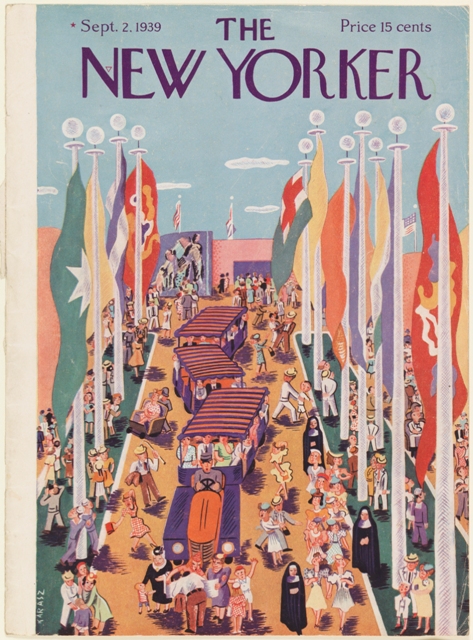When F. Scott Fitzgerald wrote The Great Gatsby in 1925, the Valley of Ashes he described as “fantastic farm where ashes grow like wheat into ridges and hills and grotesque gardens,” was a very real place. This wasteland between Brooklyn and Queens was known as the Corona Dump, where the Brooklyn Ash Removal Company disposed of the vast quantities of coal burned in New York furnaces. It may be hard to imagine, but the bright and beautiful scene gracing the cover of this issue of the New Yorker from 1939 is the very same place!
Robert Moses, the infamous city Parks Commissioner, purchased the Corona Dump in the 1930s, and the Valley of Ashes was transformed into what would become the site of the 1939 New York World’s Fair. The World’s Fair opened to the public on April 30, 1939, corresponding to the 150th anniversary of the inauguration of George Washington in the nation’s first capitol, New York City. The fair’s theme was “Building the World of Tomorrow”, and was designed to be the “everyman’s fair”, demonstrating what man could attain for himself and for his community.
This playful New Yorker cover honoring the World’s Fair was designed by Hungarian born designer Ilonka Karasz. Between 1924 and 1973, Karasz published 186 covers for the New Yorker, many of which featured scenes of New York. Karasz was a tremendously versatile artist whose artistic oeuvre was instrumental in introducing European modernism in the United States. Her design for the September 2, 1939 issue depicts the bustling Avenue of Patriots, which connected Bowling Green in the Community Interests Zone with the iconic Trylon and Perisphere at the center of the fairgrounds.
Karasz’s joyful depiction of the World’s fair is filled with families, couples, sailors, and even a few adventurous nuns. An article from this issue of the New Yorker explains that to accommodate the large number of visitors (an estimated 26,000,000 in the first season alone) and the vastness of the fairgrounds (more than 1,216 acres), “there are roller chairs pushed by guides, electrified motor chairs, Fair-ground buses with regular routes and stations, tractor-pulled trains of 3 open coaches, and sightseeing buses with lecturers.” If you look carefully, you may be able to find many of these features cleverly incorporated into the design.
